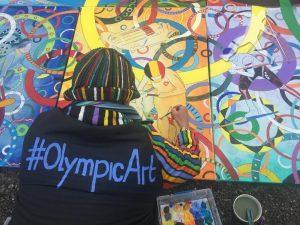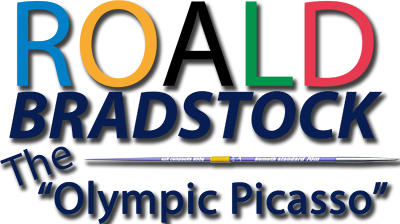
20 Mar Roald Bradstock
“I want to embrace the Olympic values of respect, friendship and excellence in the execution of this project.”
Roald Bradstock is a two-time British Olympic javelin thrower (GBR- 1984 & 1988) and an award winning international Olympic sports artist (USA – 2000). Bradstock’s antics on and off the field have gained a lot of attention in recent years. He has turned the javelin runway into a fashion runway, wearing hand-painted outfits and throwing matching hand painted optical javelins. He holds dozens of “official” and “unofficial” throwing world records for throwing a javelin, golf ball (170 yards), iPod (154 yards) and even a vinyl record (112.10 meters) to name but a few. The videos of his “Performance Art” in competitions and training have millions of views on YouTube (“roald62”). Bradstock’s unique artistic style, skill and innovative techniques in his drawings, paintings and collages have gained him international recognition. In 2000 he won the United States Olympic Committee (USOC) Sport Art Competition, and in 2003 Bradstock won the prestigious International Sports Artist of the Year award, given by the United States Sports Academy (USSA) and the American Sports Art Museum and Archives (ASAMA).
In 2005, Bradstock became the first ever Official Artist for USA Track & Field (USAT&F). In 2006 he became a founding member of an international association of Olympian artists called Art of the Olympians (AOTO), founded by four-time consecutive Olympic discus champion and abstract artist Al Oerter. That same year, after pitching multiple proposals and ideas to the London Organising Committee for the (2012) Olympic Games (LOCOG) on how to use sport and art to promote the Olympic Games, he was appointed by the British Government as a Sport and Art Olympic Ambassador for UK’s Youth Sport Trust’s (YST) 2012 Olympic Legacy Programme. Bradstock has A-Levels in Drawing, Painting and Sculpture and has a Studio Art Degree from the Southern Methodist University (SMU) in Dallas, TX in drawing, painting and printmaking. Since 1996 he has been a full-time professional artist. And since 2000 he has focused exclusively on sport as a subject matter for his artwork and an inspirational source for his ideas, creations and concepts.
“this project has opened the door to change things – using Olympians at the core to blend the two – sport and art – into ONE universal language.”
-Roald Bradstock
Interview
What do you think about this experience? What is your overall opinion/feeling?
This has been the most incredible experience of my life. It is a dream come true! To hear athletes comments, unscripted and unrehearsed, saying what l have thought and felt for so long was just amazing! I realized l wasn’t alone, that others saw and felt the same with regard sport and art.
How did the athlete react when they met you on the field? Did they participate?
We had a total of 111 Olympians from 39 countries that participated including IOC President, WOA President, HSH Prince Albert and 2 members of the de Coubertin family.
According to you, did the athlete respond well to this art initiative?
The athletes responded even better than l could have hoped for this art initiative. lt was so much fun seeing, individuals, couples and groups from so many different countries and sports coming in to paint – putting their little touch onto a canvas using a dab of coloured paint. They felt included in something and were allowed to express themselves – they had to choose from dozens of different sized brushes and over a hundred different coloured paints. I was astonished to hear athletes talk about the similarities between sport and art.
Will this project change the way you apprehend Olympic Art in the future?
This was a turning point in Olympic History, embracing an old idea but in a new way – involving Olympians in a sport and art activity. I believe this can, will and should become an ongoing activity in every Winter, Summer and youth Olympics going forward in the athlete’s villages – there are so many possibilities of how to expand and grow this.
What was your most challenging moment?
The most challenging part of this project was getting everything prepared – this was a first and a lot of work had to be done to ensure a successful outcome.
And your most memorable moment? The moment you will keep in mind.
There isn’t a single moment that l can pick out. It was a continuous flow of incredible moments for 17 days from president Bach spending 40 minutes with the artists and painting, to a figure skater wanting me to paint the Olympic rings on his skates, to seeing all the athletes laughing and having fun painting during one of if not THE most stressful times of their young lives. But there was one person and one comment that stood out from all the rest:All the canvases were spread out around the inside of box. A man comes in, looks around at all the artwork and several athletes painting and says “Ah….Olympic Values!” Lanny and l looked at each other and both smiled – if that doesn’t say it all.
What are your biggest takeaways?
My biggest take away from this is that Pierre de Coubertin was absolutely right bringing together sport and art – the two universal languages that connects us all. The challenge has been that these two language have been on parallel paths, moving along side by side but for the most part, separate and disconnected, until now that is. I believe this project has opened the door to change things – using Olympians at the core to blend the two – sport and art – into ONE universal language to bring us all together and promote the Olympic movement, its values and ideals.


